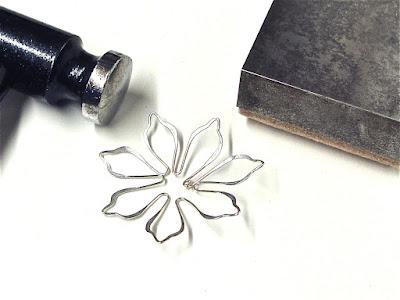I think it's because wire is such a versatile material,
which means that I am always still learning and trying
to develop new designs and techniques. Through teaching,
I can share what I've learnt and evolve with new ideas...
Recently, I had the pleasure of teaching a lovely
South African lady called Alwine, who is currently living
in Switzerland. She flew over, having booked a weekend
workshop with me and shared her lifetime dream,
of one day ... setting up a Creative Retreat in Provence,
France, running jewellery classes! Such a wonderful
idea!
We covered many different wire jewellery techniques
over the two days and amongst the designs she was
keen to create, was a CAT design. Unfortunately, our time
ran out to fit that in, so I now dedicate this tutorial to:
Alwine!
CATS
the top right hand cat design had the most appeal. The head is
created separately to the body, which means you can make
cat 'head' earrings and and if desired, attach a 'body' for a brooch
or pendant. The design also works well secured onto a greetings
card, for any of your cat lover friends!
CAT Instructions
1. I used approximately 6"-15cm of 0.8mm wire and placed
my round nosed pliers near to the centre of the length to
form 2 complete (eye) loops. Make sure the projecting wires
are straightened out on each side, angled in opposite directions.
2. Place flat nosed pliers next to the projecting wires (of the eye
loops) and bend back down on each side, to form the triangular
'ears'.
3. Place a cylindrical mandrel such as pen (I used my 8mm
bail maker pliers), under the 'eye' loops and curve the wire
around, back towards the top of the head to form the
'cheeks' on each side.
4. Place the tip of your round nosed pliers at the end of one of
the projecting wires and create a small link. Then, continue
to spiral the wire around this link until it's positioned at the
centre, forming the cat's 'nose'.
5. Thread the leftover projecting wire through the small central
link of the 'nose' spiral and form a second spiral (this one tight,
without a central hole).
6. Curl the spiral right up to the 'nose' (in step 4) and flatten it
over, so that both spirals sit on top of each other.
7. To form the 'whiskers', cut 3 lengths of 0.4mm wire (say about
2"-5cm each). For each length, thread the wire through the central
link of the 'nose' spiral (you might have to lift the flattened top
spiral to wiggle the wire through!). Secure the wire on each side
of the frame with a couple of wraps and then cut off any excess
and neaten the end.
8. Repeat the above, to create two more whiskers.
9. Using a dab of glue (E6000 is my favourite!) you can attach
seed beads, or flat back crystals over the 'eye' and 'nose' areas.
Above, are some earrings I created for my young nieces.
The ones on the right, are the same as the tutorial.
(The other cat silhouette earrings are made out of one piece of
wire with the centre crystal beads wired on with 0.4mm wire.)
If you wish to create a body for the cat, here are a couple of
shape suggestions:
Create a wire outline out of 0.8mm wire and secure to the
cat head, as shown.
you scrunch some 0.3mm wire and 'sew' this into the body
frame, so that the brooch pin finding cannot be seen.
The outline below, is another shape option.
You could even wire stripes to it with 0.4mm and colour
them in for a card design, or, weave them in with 0.4mm wire.
I hope that Alwine's request for a CAT design has also given
YOU some inspiration! It's not purrrrfect, however it
might trigger your own versions.
P.S. if you prefer to make a dog, you could always omit the whiskers!












































